Immediate responses to a sanitation crisis caused by an emergency include a wide range of solutions, highly depending on physical conditions on the ground, but also the living situation of the affected population temporarily living in a densely populated place (e.g. a refugee camp) or near their houses in a scattered situation (e.g. in rural areas). Although the first month after an event requires speedy solutions, their suitability with longer-term considerations is important. If possible, the solutions entail on-site excreta disposal without treatment. An upgrading approach is usually chosen after a few weeks.
Adapted from HARVEY (2007)
The first emergency phase covers the immediate interventions and typically lasts from one to three months. They aim at providing basic facilities to contain and separate excreta, to prevent transmission of faecal-oral diseases and the contamination of water sources (see also sanitation in emergencies). Emergency situations do not follow a linear progression: some situations may become more acute after improvements, e.g. when the affected population increases, an epidemic occurs, or the security deteriorates.
The priority in the immediate phase is the speed of installing the technologies to contain excreta. The transport system, available resources on the ground, and possibly an on-going disaster event are challenging constraints (HARVEY 2007).
Immediate interventions are implemented rapidly and designed for short-term use. Because the options may have limited socio-cultural acceptability and sustainability, members of the affected community should be consulted regarding the distribution and type of facilities. However, it is important that future disposal options are considered already at this stage to ensure that they do not have detrimental effects on medium or longer term emergency sanitation (HARVEY 2007).
| Priorities | Containment of excreta in the quickest time possible |
| Stakeholder Involvement | Community, neighbourhood or camp level |
| Strategy & Technology Choice | Repair of existing facilities
Dense target populations (displaced): Control of indiscriminate defecation (managed open defecation); shallow and deep trench latrines
Scattered target populations (displaced or 'in-situ'): Wrap, contain and collect
For both situations: pit latrines; borehole latrines; peepoo bag; simple urine diverting toilets; arborloos; raised latrines / floating toilets |
Priorities, stakeholder involvement and technology choice for the immediate sanitation actions in an emergency response. Source: Adapted from JOHANNESSEN & BIKABA (2009)
While certain emergency phases can be defined, the choice of the actual sanitation system for each phase depends on the particular situation e.g. if people live scattered, in urban areas, and the actual needs related to sanitation. The following options have been used in the past during the immediate emergency response, most of the options use on-site excreta disposal without treatment.
In most emergency situations it is possible to use on-site excreta disposal systems whereby human wastes are disposed of without treatment. These facilities include open defecation fields, trench latrines, borehole latrines, or pit latrines. Other options exist where infiltration is not possible, e.g. in urban environments, high water levels, rocky terrains that do not allow pits to be dug, or where prevention of groundwater contamination is crucial (HARVEY et al. 2002; HARVEY 2007). Some of these constraints and other reasons (fill up time of a latrine) make urine diverting toilets or other options such as arborloo preferable, even in the immediate emergency phase (OXFAM 2009; RUBERTO & JOHANNESSEN 2009).
Dense Target Populations (Displaced): Managed Open Defecation and Trench Latrines
In displacement situations and presence of a large number of people, managed open defecation can be an extreme but feasible short-term solution given that enough space is available. Groundwater contamination has to be avoided by any means by choosing an appropriate site. Hand washing facilities and supervision should be organised and all excreta should be covered with soil as soon as possible (HARVEY 2007). In practice, this method does not seem to be very widely implemented (JOHANNESSEN & BIKABA 2009).

Trench latrines are a simple improvement of open defecation fields and seem to be used more frequently in emergencies (JOHANNESSEN & BIKABA 2009). They allow users to cover faeces and improve the overall hygiene and convenience of an open defecation system. Where large amounts of flies (potential carriers of vector-borne diseases) pose a problem, vector control equipment can be used (see OXFAM 2000). Trenches only need to be 20 to 30cm wide and 15cm deep for shallow trench latrines or up to 2 metres deep for deep trench latrines. They should be located at a distance of 15-30 meters of any groundwater source and the bottom of any latrine at least 1.5 metres above the water table. Latrines should be backfilled before they are filled up completely (20cm beneath the slab) (HARVEY 2007; JOHANNESSEN & BIKABA 2009).
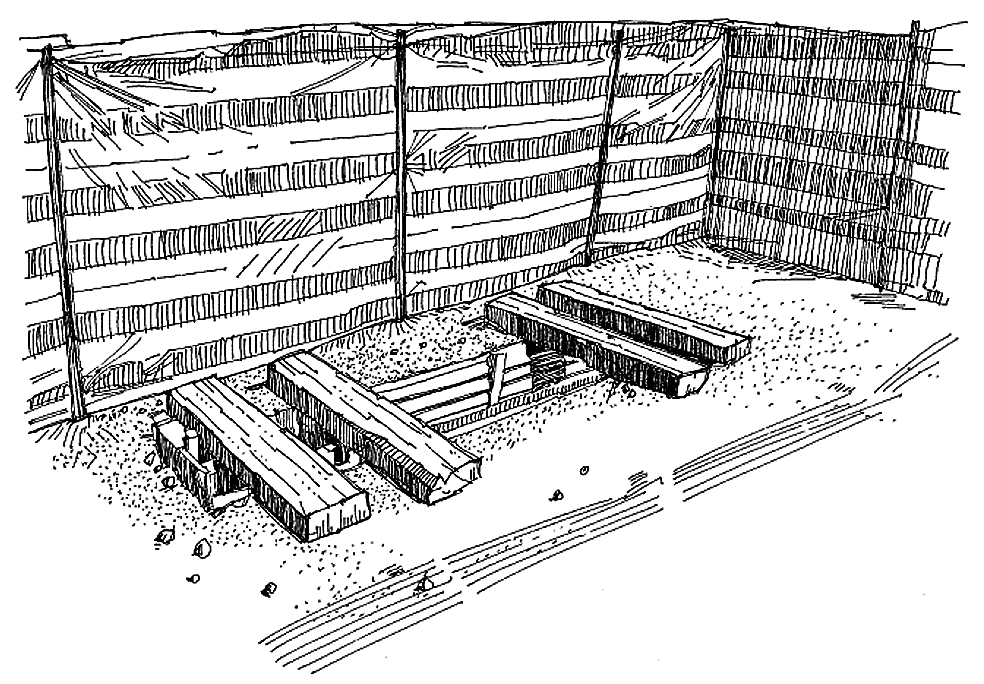
Since deep trench latrines need some kind of lining, they are often enhanced with a timber superstructure or even a pour-flush toilet (wet latrine systems, if water available). Trench latrines can be constructed for many people or for families (see HARVEY et al. 2002).
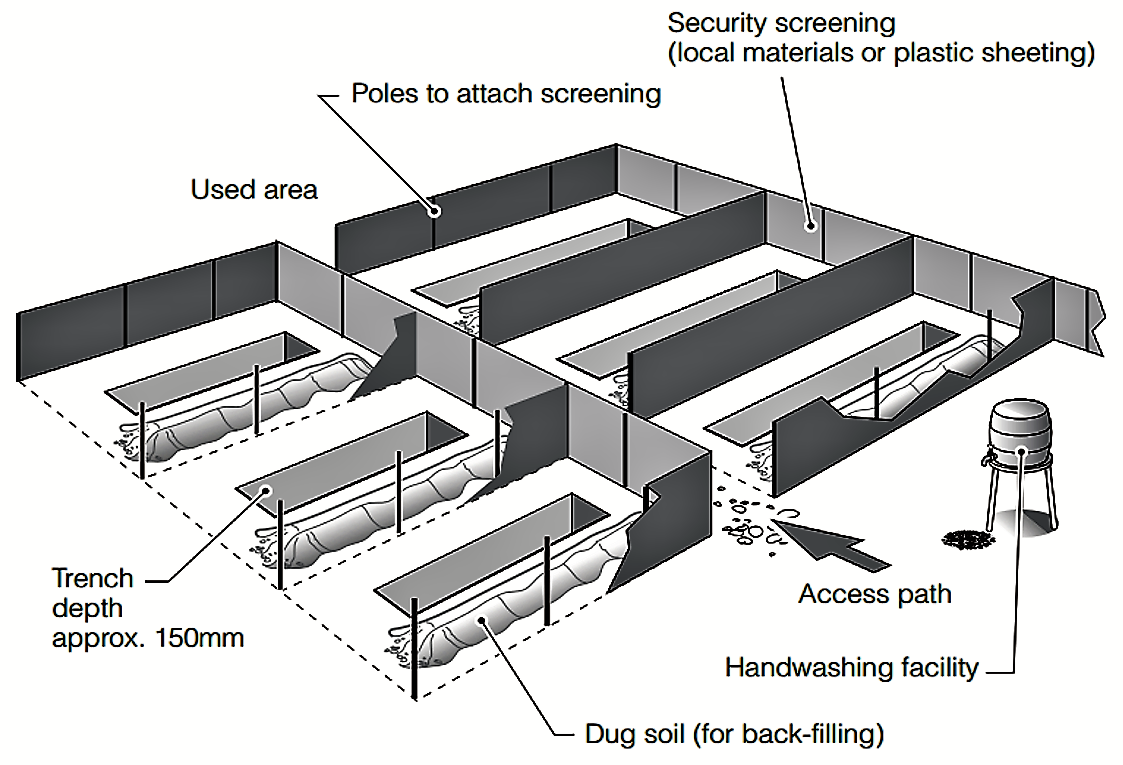
Some other options for the immediate emergency phase include bucket or container latrines, storage tank latrines, (plastic) packet latrines or chemical toilets (HARVEY et al. 2002; HARVEY 2007).
In-situ Target Population: Wrap, Contain and Collect
For “in-situ” situations, repair of existing toilet facilities may be the best option. During floods, household toilets repair might not be possible and to prevent further contamination of flood and ground water, the “wrap, contain and collect” technique can be applied. Excreta is stored in buckets or bags and collected (e.g. by a “sanitation boat”) and brought to a treatment site (PEN 2010).
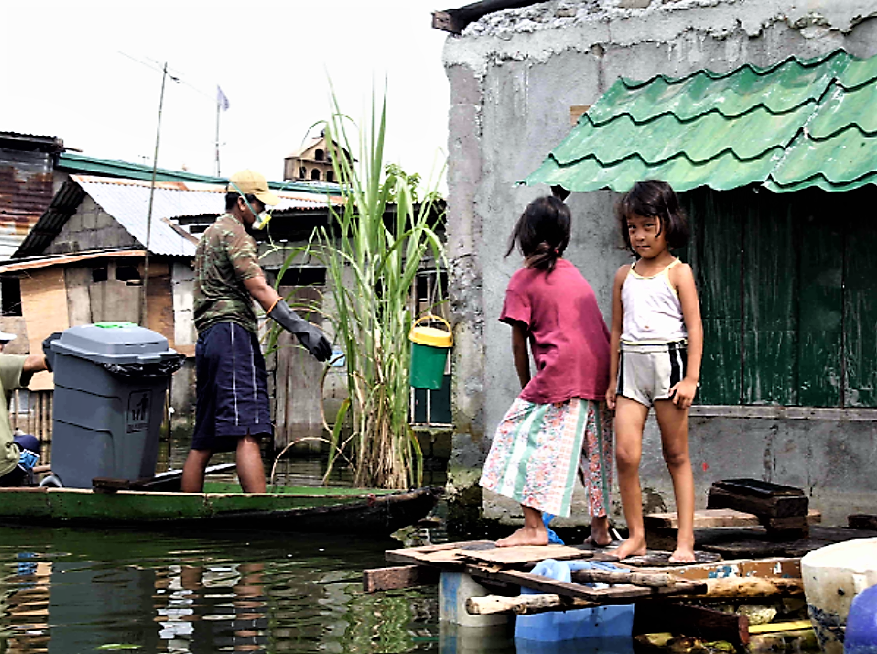
Latrines
Simple, squatting pit latrines without flushing devices are by far the most common technology choice adopted in emergency situations. This is because they are simple, quick to construct and generally inexpensive. But they are unsuitable where water table is high or soil is too unstable or too rocky.
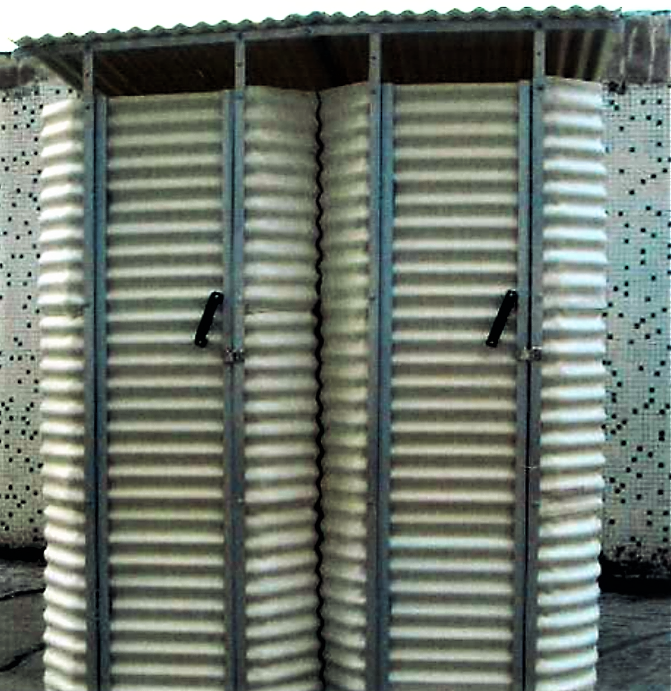
Depending on the situation, immediate action could be to build shallow communal, shared or family latrines, depending on the available space and time (supervision). Whenever possible, experience in latrine construction and motivation of people should be taken in account. While family trench latrines increase privacy compared to community latrines, they are difficult to manage. A shallow pit is approx. 0.3m x 0.5m and 1m deep; yet, the size depends on the number of users. All pits should be safely sealed with a top.
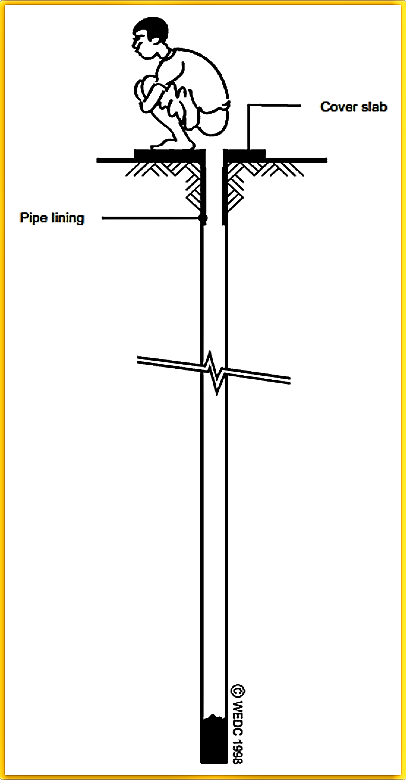
Multifunctional slabs for pit latrines are promoted by emergency organisations. They are preferably designed for the use as urine diverting slabs. It allows for immediate separation of urine, which prolongs the life of shallow, trench or pit latrines (JOHANNESSEN 2011). When considering an upgrading of emergency sanitation in subsequent phases, the further use of urine diversion toilets can be considered (see medium term emergency sanitation). When pits are used for longer time (which is most often the case), the emptying of pits should be taken into account (HARVEY et al. 2002; JOHANNESSEN 2011);see also human powered and motorised emptying and different options for sludge treatment: small scale and large scale composting, anaerobic digestion, drying beds, settling ponds, or pequena and large scale incineration.
Borehole latrines are an alternative where ground conditions allow it and tools and labour are immediately available locally.
Peepoo Bag
In emergencies, the use of normal plastic bags or peepoo bags is advisable in immediate intervention at the household level until community or proper toilets can be built, when settlements experience chronic space or land-use limitations, where de-sludging is difficult, or where certain (vulnerable) groups prefer to defecate in personal shelters. Both, plastic or biodegradable bags, contribute to reducing open defecation and “flying toilets” in an urban disaster (PATEL et al. 2011).
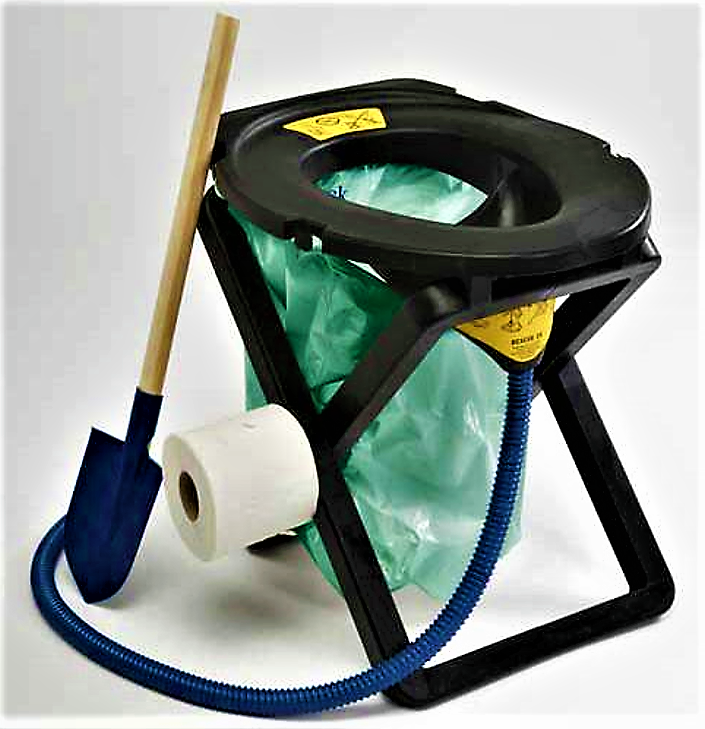
The peepoo bag is a personal, single-use toilet that sanitises human excreta shortly after defecation. This is done within a degradable bioplastic bag coated with urea. It requires no water except for hand washing. The System has proven to be useful during the acute intervention phase (until more appropriate toilets are built), during flooding, and for night time use, especially by women (VON MUENCH et al. 2009).
Raised or Elevated Latrines
Elevated latrines (also: raised latrines) are useful when groundwater level is high, when digging is not possible due to hard soil or lacking landownership. Water-sealed latrines or latrines on higher ground could be alternatives (JOHANNESSEN & BIKABA 2009). Challenges of raised latrines include slow and costly installation and the need for more frequent desludging (see human powered and motorised emptying) (see also OXFAM 2009). Diversion of urine prevents excreta collection chambers to fill up too quickly (see also urine diversion toilets and urine diversion components).
Although requiring some construction time, the elevation concept can be applied to a floating version if dry land for construction is scarce. In the Philippines, the floating version has been enhanced with digestion chambers where anaerobic decomposition occurs (Floating Sanitary Toilet, FST). The effluent then goes to the treatment chamber, which further improves the quality of the wastewater to an acceptable level (NORTHERN WATCH 2009).
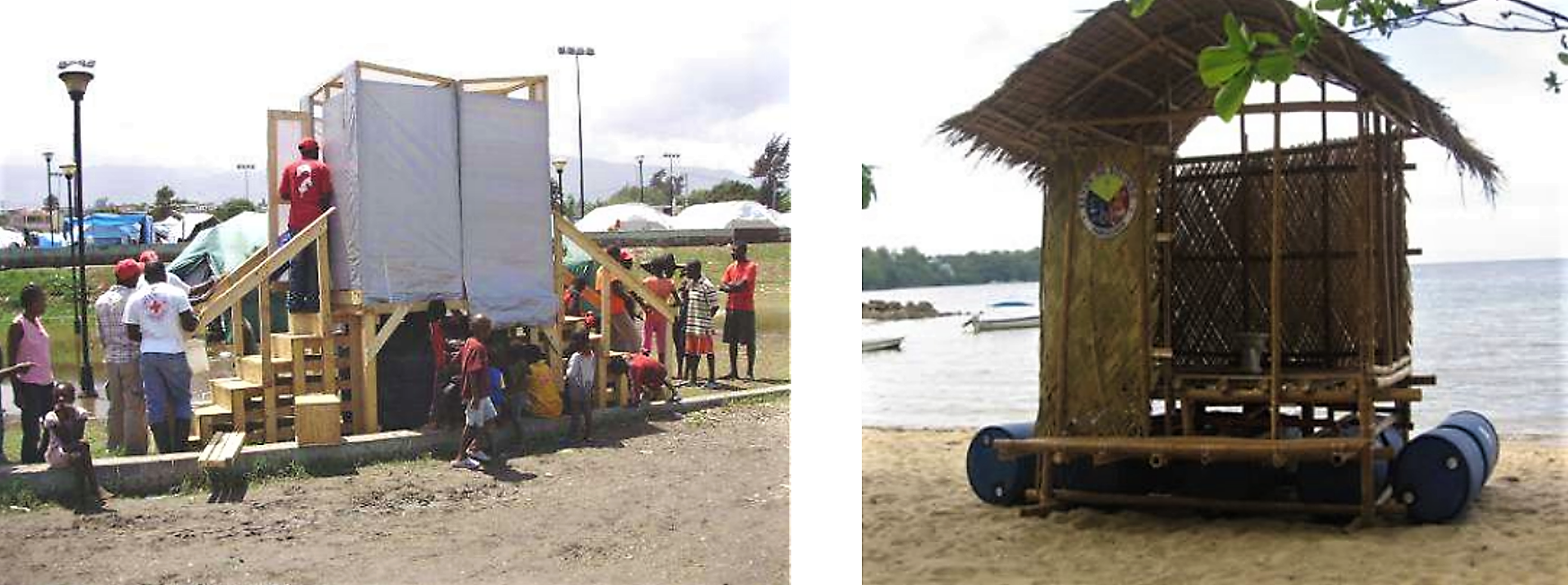
Emergency Sanitation: Assessment and Programme Design
This book has been written to help all those involved in planning and implementing emergency sanitation programmes. The main focus is a systematic and structured approach to assessment and programme design. There is a strong emphasis on socio-cultural issues and community participation throughout.Includes an extensive “guidelines” section with rapid assessment instructions and details on programme design, planning and implementation.
HARVEY, P. BAGHRI, S. REED, B. (2002): Emergency Sanitation: Assessment and Programme Design. Loughborough: Water, Engineering and Development Centre (WEDC) URL [Accessed: 31.05.2019]Excreta Disposal in Emergencies. A Field Manual
In this manual existing, innovative and new technologies and approaches for excreta disposal in emergency situations are investigated. It provides practical guidance on how to select, design, construct and maintain appropriate excreta disposal systems to reduce faecal transmission risks and protect public health in emergency situations.
HARVEY, P.A. (2007): Excreta Disposal in Emergencies. A Field Manual. Leicestershire: WEDC Loughborough University URL [Accessed: 29.07.2011]Meeting Water Sanitation and Hygiene Needs in Emergencies
Sustainable Sanitation for Emergencies and Reconstruction Situations - Factsheet of Working Group 8 (draft)
This well structured and informative factsheet from the SuSanA network deals with the planning of sustainable sanitation for emergencies and reconstruction situations in low- and middle-income countries.
JOHANNESSEN, A. BIKABA, D. (2009): Sustainable Sanitation for Emergencies and Reconstruction Situations - Factsheet of Working Group 8 (draft). Eschborn: Sustainable Sanitation Alliance SuSanA URL [Accessed: 23.04.2012]Identifying Gaps in Emergency Sanitation. Design of New Kits to Increase Effectiveness in Emergencies
Floating Sanitary Toilets Launched in Balibao
Safer Sanitation in Slums and Emergency Settings with Peepoo Bags
Water, Sanitation, and Shelter Equipment
These equipment packages have been devised by the Oxfam Public Health Engineering Team and others to help provide a reliable water supply, primarily for emergency situations such as in refugee camps and disaster-relief operations. The equipment is designed to be readily available, easily transported, simple to use, rapidly assembled, and fully self-contained, to provide an adequate water supply at moderate cost.
OXFAM (2000): Water, Sanitation, and Shelter Equipment. For Emergencies and Longer Term Use. Oxford: OXFAM URL [Accessed: 21.05.2019]UD Toilets and Composting Toilets in Emergency Settings
Excreta Disposal in Emergencies. Bag and Peepoo Trials with Internally Displaced People in Port-au-Prince
Philippine Emergency Sanitation Reference Toolkit. Excreta Disposal
This toolkit is a compilation of existing relevant sanitation focused emergency response mechanisms, technologies and experiences to support institutions and local government units in disaster response. It was developed in the aftermath of cyclone Ketsana in 2009.
PEN (2010): Philippine Emergency Sanitation Reference Toolkit. Excreta Disposal. Manila: The Philippine Ecosan Network (PEN)Innovations in Emergency Sanitation. International Water Association (IWA)
This document summarises the discussion and outcomes of an expert workshop in 2009, identifying useful ideas that can improve sanitation practices in terms of sustainability but are still suitable for emergency situations. It includes inputs from various experts from the sector.
RUBERTO, C. JOHANNESSEN, A. (2009): Innovations in Emergency Sanitation. International Water Association (IWA). (= 2-day Workshop, 11-13 February 2009 ). Stoutenburg: The Netherlands URL [Accessed: 09.06.2019]Rescue Camping 25
Technical Notes on Drinking-Water, Sanitation and Hygiene in Emergencies
These technical notes are relevant to a wide range of emergency situations, including both natural and conflict-induced disasters. They are suitable for field technicians, engineers and hygiene promoters, as well as staff from agency headquarters.
WHO ; WEDC (2013): Technical Notes on Drinking-Water, Sanitation and Hygiene in Emergencies. Geneva: World Health Organization (WHO) URL [Accessed: 27.08.2013]Compendium of Sanitation Systems and Technologies (Arabic)
This is the Arabic version of the Compendium of Sanitation Systems and Technologies. The Compendium gives a systematic overview on different sanitation systems and technologies and describes a wide range of available low-cost sanitation technologies.
TILLEY, E. ULRICH, L. LUETHI, C. REYMOND, P. SCHERTENLEIB, R. ZURBRUEGG, C. (2014): Compendium of Sanitation Systems and Technologies (Arabic). 2nd Revised Edition. Duebendorf, Switzerland: Swiss Federal Institute of Aquatic Science and Technology (Eawag) PDFAvailability and Type of Latrine Facility: 2001-2011
Statistics of availability and type of latrine facility.
CHANDRAMOULI, C. (2012): Availability and Type of Latrine Facility: 2001-2011. New Dehli: Census of India, Government of India URL [Accessed: 09.06.2019]India Census: More People Have a Mobile Phone than a Household Toilet
Nearly half of India’s 1.2 billion people have no toilet at home, but more people own a mobile phone, according to the latest census data.
DIETVORST, C. (2012): India Census: More People Have a Mobile Phone than a Household Toilet. Sanitation Update URL [Accessed: 20.03.2012]Excreta Disposal in Emergencies. A Field Manual
In this manual existing, innovative and new technologies and approaches for excreta disposal in emergency situations are investigated. It provides practical guidance on how to select, design, construct and maintain appropriate excreta disposal systems to reduce faecal transmission risks and protect public health in emergency situations.
HARVEY, P.A. (2007): Excreta Disposal in Emergencies. A Field Manual. Leicestershire: WEDC Loughborough University URL [Accessed: 29.07.2011]Sustainable Sanitation for Emergencies and Reconstruction Situations - Factsheet of Working Group 8 (draft)
This well structured and informative factsheet from the SuSanA network deals with the planning of sustainable sanitation for emergencies and reconstruction situations in low- and middle-income countries.
JOHANNESSEN, A. BIKABA, D. (2009): Sustainable Sanitation for Emergencies and Reconstruction Situations - Factsheet of Working Group 8 (draft). Eschborn: Sustainable Sanitation Alliance SuSanA URL [Accessed: 23.04.2012]Design of a Portable Ecological Sanitation Toilet for Disaster Relief
A portable toilet appropriate for disaster response is presented in this report. The urine is diverted and the feces undergo a lactofermentation process. Biochar is added also to the feces to eliminate odor and facilitate the reuse of the excreta as a soil additive. The design, costs, logistics and expected challenges are discussed.
KINSTEDT, K. (2012): Design of a Portable Ecological Sanitation Toilet for Disaster Relief. Hamburg: Institute of Wastewater Management and Water Protection at the Technical University of Hamburg URL [Accessed: 09.06.2019]Philippine Emergency Sanitation Reference Toolkit. Excreta Disposal
This toolkit is a compilation of existing relevant sanitation focused emergency response mechanisms, technologies and experiences to support institutions and local government units in disaster response. It was developed in the aftermath of cyclone Ketsana in 2009.
PEN (2010): Philippine Emergency Sanitation Reference Toolkit. Excreta Disposal. Manila: The Philippine Ecosan Network (PEN)Innovations in Emergency Sanitation. International Water Association (IWA)
This document summarises the discussion and outcomes of an expert workshop in 2009, identifying useful ideas that can improve sanitation practices in terms of sustainability but are still suitable for emergency situations. It includes inputs from various experts from the sector.
RUBERTO, C. JOHANNESSEN, A. (2009): Innovations in Emergency Sanitation. International Water Association (IWA). (= 2-day Workshop, 11-13 February 2009 ). Stoutenburg: The Netherlands URL [Accessed: 09.06.2019]Humanitarian Crises and Sustainable Sanitation: Lessons from Eastern Chad
How important is sanitation during a humanitarian crisis? Why is it important to explore ecological and sustainable sanitation? Groupe URD looks at the case of Eastern Chad, an example of a major long-term crisis. From an acute emergency in 2003, the crisis has gone through a number of phases. The appropriateness of aid mechanisms is currently being questioned, with a particular focus on sanitation. Sustainable sanitation can help to improve the quality of life of refugees and IDPs as well as local populations. From this perspective, what lessons from Eastern Chad could be useful in other contexts?
U.R.D. (2012): Humanitarian Crises and Sustainable Sanitation: Lessons from Eastern Chad. Plaisians: Groupe URD (Urgence Réhabilitation Développement) URL [Accessed: 09.06.2019]Technical Options for Excreta Disposal in Emergencies. Technical Notes on Drinking-Water, Sanitation and Hygiene in Emergencies
Initially, indiscriminate defecation is usually the main health hazard in refugee camps. This technical note outlines ways in which excreta and urine can be managed during the early stages of an emergency, while long-term solutions are devised.
REED, B. (2013): Technical Options for Excreta Disposal in Emergencies. Technical Notes on Drinking-Water, Sanitation and Hygiene in Emergencies. (= Technical Notes on Drinking-Water, Sanitation and Hygiene in Emergencies , 14 ). Geneva: World Health Organization (WHO) URL [Accessed: 01.10.2013]Technical Notes on Drinking-Water, Sanitation and Hygiene in Emergencies
These technical notes are relevant to a wide range of emergency situations, including both natural and conflict-induced disasters. They are suitable for field technicians, engineers and hygiene promoters, as well as staff from agency headquarters.
WHO ; WEDC (2013): Technical Notes on Drinking-Water, Sanitation and Hygiene in Emergencies. Geneva: World Health Organization (WHO) URL [Accessed: 27.08.2013]Environmental Health in Emergencies and Disasters
This new book deals not only with emergency response, but also with measures designed to reduce the impact of disasters on environmental health infrastructure, such as water supply and sanitation facilities. It also aims to strengthen the ability of people to withstand the disruption of their accustomed infrastructure and systems for environmental health (e.g. shelter, water supply, sanitation, vector control etc.) and to recover rapidly.
WISNER, B. ADAMS, J. (2002): Environmental Health in Emergencies and Disasters. A Practical Guide. Geneva: World Health Organization (WHO) URL [Accessed: 20.03.2012]Water, Sanitation and Hygiene (WASH) in Health-Care Facilities in Emergencies
Health-care facilities play a vital role within the community by providing essential medical care at all times including during emergencies. Any incident which causes loss of infrastructure, energy supply, loss of equipment, loss of staff or staff attrition, interruption to supply chains, or patient surge - such as sudden communicable disease epidemics, natural disasters (e.g. floods, earthquakes), or conflict - requires a holistic health response and recovery effort which includes actions to assess and restore basic WASH services.
HARVEY, B. (2012): Water, Sanitation and Hygiene (WASH) in Health-Care Facilities in Emergencies. Technical Notes on Drinking-water, Sanitation and Hygiene in Emergencies. (= Technical Notes on Drinking-Water, Sanitation and Hygiene in Emergencies. [Accessed: 30.09.2013] , 17 ). Geneva: World Health Organization (WHO) PDFFaecal Sludge Management
Household UDDTs after cyclone disaster, Padma and Rohitra villages, Barishal Division, Bangladesh Case study of sustainable sanitation projects
This case study presents a post-rehabilitation project in Bangladesh after cyclone Sidr in 2007, which included provision of 100 twin vault UDDTs in rural villages. The three main challenges were finding an adequate place on the compound for the UDDTs, the use of UDDTs e.g. daily practices and maintenance, and the reuse of dried excreta.
DELEPIERE, A. (2011): Household UDDTs after cyclone disaster, Padma and Rohitra villages, Barishal Division, Bangladesh Case study of sustainable sanitation projects. Sustainable Sanitation Alliance (SuSanA) URL [Accessed: 09.06.2019]UDDTs in Flood-response Project. Guara-Guara, Sofala Province, Mozambique. Case Study of Sustainable Sanitation Projects
The project aimed at providing safe water supply and sanitation to the population resettled – after floods – in the less flood-prone Guara-Guara region in the Sofala Province, Mozambique. Since the area is characterised by high groundwater tables, so called “ventilated double vault urine diversion dehydration toilets” (UDDTs) were implemented to not contaminate the groundwater, and thus not threaten public health (unlike pit latrines).
FOGDE, M. MACARIO, L. PORSANI, J. (2011): UDDTs in Flood-response Project. Guara-Guara, Sofala Province, Mozambique. Case Study of Sustainable Sanitation Projects. Eschborn: Sustainable Sanitation Alliance SuSanA URL [Accessed: 09.06.2019]Ecosan Can Provide Sustainable Sanitation in Emergency Situations with Benefits for the Millennium Development Goals
This paper describes the potential of ecological sanitation (ecosan) to provide sustainable excreta disposal in emergency situations and in peri-urban areas or slums in developing countries. It proposes eight criteria for the applicability of ecosan based on analysis of three case studies representing different types of emergency situations.
MUENCH, E. von AMY, G. FESSELET, J.F. (2006): Ecosan Can Provide Sustainable Sanitation in Emergency Situations with Benefits for the Millennium Development Goals. London: IWA PublishingDelivering Water, Sanitation and Hygiene Services in an Uncertain Environment: Piloting Ecological Sanitation (EcoSan) in the Emergency Context of Port-au-Prince, Haiti, after the 2010 Earthquake
The earthquake that struck Haiti in January 2010 and the cholera epidemic that followed from October 2010, resulted in one of the largest humanitarian relief efforts in history. Many of the internally displaced persons camps were located in urban neighbourhoods with high groundwater, making onsite sanitation extremely difficult. In response to these unique conditions a small local organization, SOIL, partnered with Oxfam Great Britain to pilot urine diversion EcoSan toilets in camps throughout Port-au-Prince. This briefing paper covers this pilot project from March 2010 through March 2012. During that 2-year period, SOIL’s toilets served over 20,000 people and treated more than 400,000 gallons of human waste, converting it to rich compost.
KILBRIDE, A. KRAMER, S. PRENETA, N. (2013): Delivering Water, Sanitation and Hygiene Services in an Uncertain Environment: Piloting Ecological Sanitation (EcoSan) in the Emergency Context of Port-au-Prince, Haiti, after the 2010 Earthquake. (= WECD International Conference , 36 ). Oakland: Sustainable Organic Integrated Livelihoods (SOIL) URL [Accessed: 01.06.2019]Emergency Sanitation: Assessment and Programme Design
This book has been written to help all those involved in planning and implementing emergency sanitation programmes. The main focus is a systematic and structured approach to assessment and programme design. There is a strong emphasis on socio-cultural issues and community participation throughout.Includes an extensive “guidelines” section with rapid assessment instructions and details on programme design, planning and implementation.
HARVEY, P. BAGHRI, S. REED, B. (2002): Emergency Sanitation: Assessment and Programme Design. Loughborough: Water, Engineering and Development Centre (WEDC) URL [Accessed: 31.05.2019]Compendium of Sanitation Systems and Technologies
This compendium gives a systematic overview on different sanitation systems and technologies and describes a wide range of available low-cost sanitation technologies.
TILLEY, E. LUETHI, C. MOREL, A. ZURBRUEGG, C. SCHERTENLEIB, R. (2008): Compendium of Sanitation Systems and Technologies. Duebendorf, Switzerland: Swiss Federal Institute of Aquatic Science and Technology (EAWAG) and Water Supply and Sanitation Collaborative Council (WSSCC) URL [Accessed: 15.02.2010] PDFPlanning for Excreta Disposal in Emergencies
The pressure to help people immediately after a disaster often leads to actions starting before they have been properly planned. This Technical Note is a guide to the planning process of excreta disposal during the first two phases of an emergency. Technical options are presented in Technical Note 14.
REED, B. (2013): Planning for Excreta Disposal in Emergencies. (= Technical Notes on Drinking-Water, Sanitation and Hygiene in Emergencies , 13 ). Geneva: World Health Organization (WHO) URL [Accessed: 01.10.2013]Haiti. From Sustaining Lives to Sustainable Solutions: the Challenge of Sanitation. Special Report - Six Months on
This special report lines out the challenges faced related to sanitation during the emergency response to the devastating earthquake in Haiti in January 2010. It also emphasises the importance of planning improved sanitation in the longer term to effectively reduce disease and to ensure dignity of the affected population.
IFRC (2010): Haiti. From Sustaining Lives to Sustainable Solutions: the Challenge of Sanitation. Special Report - Six Months on. Geneva: International Federation of Red Cross and Red Crescent Societies URL [Accessed: 28.11.2011]Handbook for Emergencies. Third Edition
This extensive handbook from the UN High Commissioner for Refugees (UNHCR) on emergency responses reflects the multiple dimensions of an emergency response, ranging from emergency management to emergency operations and their support. The handbook mainly looks at emergencies where populations have been displaced from their former living environment.
UNHCR (2007): Handbook for Emergencies. Third Edition. Geneva: UNHCR Emergency Preparedness and Response Section URL [Accessed: 21.05.2019]SuSanA Working Groups
The objective of this SuSanA working group is to combine the knowledge from experts in the fields of sanitation with the knowledge from experts in the field of emergency response and reconstruction. The site includes documents, workshop inputs and presentations with best practice examples of sustainable sanitation options in emergency and reconstruction situations.
WHO Technical Notes for Emergencies
This website offers a lot of information material for practioneers in emergencies.
Sanitation Portal
The sanitation decision tool is based on the Eawag Sanitation Compendium and aims to give support in choosing the right sanitation chain components, from a spectrum of options. It shall help the user to find a tailored solution suitable for the specific context that the sanitation system will be placed in. The tool exists as a print and digital version.
Peepoo bags in Haiti
This short video explains how OXFAM implemented the use of peepoo bags in two IDP camps after the Haiti earthquake in 2010. This toilet solution includes latrine cubicles that address the dignity and privacy issue often criticised in connection with peepoo bags.
SuSanA Working Groups
The objective of this SuSanA working group is to combine the knowledge from experts in the fields of sanitation with the knowledge from experts in the field of emergency response and reconstruction. The site includes documents, workshop inputs and presentations with best practice examples of sustainable sanitation options in emergency and reconstruction situations.
WatSan Mission Assistant
This site has a wealth of resources for water, sanitation and hygiene (WASH) practitioners collected by the International Federation of Red Cross and Red Crescent Societies (IFRC) with a focus on emergency situations.

